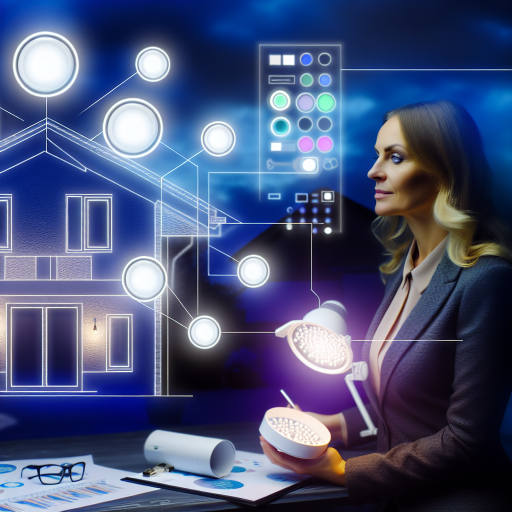Introduction to Smart Home Technology and its Importance for Accessibility
Defining Smart Home Technology
Smart home technology refers to devices that automate tasks within your home.
These devices connect through the internet, allowing remote control and monitoring.
Common examples include smart lights, thermostats, and security systems.
Each device works together to create a cohesive smart ecosystem.
Importance of Accessibility
Accessibility ensures everyone can enjoy their living spaces to the fullest.
For individuals with disabilities, barriers can hinder basic everyday tasks.
Smart home technology provides solutions that promote independence.
Improved accessibility enhances quality of life significantly.
Benefits of Smart Home Solutions for Accessibility
Smart home solutions offer numerous advantages for accessibility needs.
Automation helps individuals control home environments without physical exertion.
For example, voice-activated devices allow hands-free operation.
Additionally, remote monitoring provides peace of mind for caregivers.
Smart sensors can alert residents of potential hazards, contributing to safety.
Promoting Inclusivity with Smart Technology
Incorporating smart technology fosters an inclusive living environment.
Technology can be tailored to accommodate diverse needs and preferences.
For instance, customizable interfaces cater to users with visual impairments.
This flexibility ensures that everyone can benefit from smart solutions.
Overview of Accessibility Features in Smart Homes
The Importance of Accessibility
Accessibility plays a critical role in our daily lives.
It ensures that everyone can enjoy their home environment comfortably.
Smart home technology significantly enhances accessibility features.
These innovations help individuals with varying abilities.
Types of Accessibility Features
Smart homes offer various features designed for accessibility.
Voice-activated systems allow easy control of devices.
Automated lighting enhances visibility in different areas.
Smart thermostats provide comfortable temperatures for all users.
Additionally, door sensors alert residents to entries and exits.
Integration of Assistive Technologies
Integrating assistive technologies can provide substantial benefits.
For instance, wearable devices assist individuals with mobility issues.
Navigation apps improve orientation in and out of the home.
Furthermore, smart speakers can facilitate communication needs.
Enhancing Security and Safety
Smart home systems improve security and safety for all residents.
Automated door locks ensure secure access to the home.
Surveillance cameras provide peace of mind for families.
Emergency response systems can alert services immediately.
Benefits of Smart Home Accessibility Features
Smart home technology offers various benefits.
It promotes independence for individuals with disabilities.
Additionally, it creates a more inclusive living environment.
Ultimately, enhanced accessibility leads to a better quality of life.
Types of Smart Home Devices that Enhance Accessibility
Smart Speakers
Smart speakers can help individuals control their home hands-free.
They allow users to operate other smart devices using voice commands.
Additionally, speakers can provide reminders and information on demand.
Smart Lighting Systems
Smart lighting systems improve accessibility through voice or app control.
These systems can adjust brightness and color to suit personal preferences.
Moreover, they can be programmed to turn on or off at specific times.
Smart Door Locks
Smart door locks increase security and accessibility for users.
They allow remote access without needing a physical key.
Many models feature keyless entry codes for added convenience.
Smart Thermostats
Smart thermostats help regulate home temperature with ease.
Users can adjust settings remotely via smartphone apps.
This feature is especially beneficial for individuals with mobility challenges.
Smart TV and Entertainment Systems
Smart TVs offer features that enhance accessibility for all users.
They include voice control options and text-to-speech functionalities.
Television programming can be customized for easier navigation.
Smart Home Security Cameras
Smart security cameras provide peace of mind for homeowners.
They can be monitored remotely through mobile devices.
These systems often include motion alerts and video recording capabilities.
Smart Assistive Devices
Various assistive devices utilize smart technology for enhanced usability.
For example, smart pill dispensers remind users to take their medication.
Additionally, smart mobility aids can improve navigation and independence.
Smart Sensors
Smart sensors detect movement and environmental changes effectively.
They can alert users to potential hazards within the home.
For instance, smoke or leak detectors provide timely warnings.
Gain More Insights: Evaluating Home Automation Hubs For Real Estate Buyers Seeking Convenience
Voice-Controlled Assistants and Their Role in Home Accessibility
Enhancing Independence Through Voice Technology
Voice-controlled assistants serve as powerful tools for promoting independence.
They empower individuals with mobility challenges to control their environment seamlessly.
In addition, these assistants provide hands-free operation for various household tasks.
For example, users can adjust lighting or temperature with simple voice commands.
Features That Boost Accessibility
Many voice-controlled assistants feature enhanced accessibility options.
These options include customized voice recognition and response settings.
Adjusting these settings makes it easier for people with disabilities to communicate.
Moreover, voice assistants can integrate with other smart devices in the home.
- Smart lights can be turned on or off by voice command.
- Smart locks provide security without needing manual operation.
- Thermostats can be adjusted to comfort levels through voice prompts.
Popular Voice-Controlled Assistants
Several voice-controlled assistants are widely used for home accessibility.
Amazon Echo utilizes Alexa, a versatile voice assistant.
Similarly, Google Home features the Google Assistant.
Both provide robust options for controlling smart home devices.
Apple’s HomePod employs Siri, focusing on seamless integration with iOS devices.
Benefits Beyond Convenience
These assistants substantially improve safety for individuals at home.
For instance, they can alert emergency contacts or services via voice commands.
This capability is crucial for those with medical needs or emergencies.
Furthermore, they help reduce feelings of isolation by connecting users with others.
Challenges and Future Developments
Despite their benefits, challenges remain with voice-controlled technology.
Some users may experience frustration with voice recognition inaccuracies.
As technology advances, enhancements in speech recognition are anticipated.
Future updates may include more personalized interactions and better understanding.
See Related Content: How Smart Appliances Directly Influence Rental Income For American Landlords
Smart Lighting Solutions for Individuals with Vision Impairments
Understanding Smart Lighting
Smart lighting refers to advanced lighting systems that can be controlled remotely.
These systems offer various features, such as dimming and color adjustment.
Furthermore, they allow users to customize their lighting settings easily.
Benefits of Smart Lighting
Smart lighting enhances accessibility for individuals with vision impairments.
It provides improved visibility in different areas of the home.
This technology aids in preventing accidents and falls by illuminating dark spaces.
Additionally, users can adjust brightness levels according to their needs.
Types of Smart Lighting Solutions
- Motion-sensor lights provide automatic illumination when someone enters a room.
- Voice-activated lighting systems offer hands-free control for convenience.
- Color-changing smart bulbs allow users to choose shades based on comfort.
- Programmable timers enable consistent lighting when needed.
Implementing Smart Lighting
Start by assessing the areas of your home that require better lighting.
Choose smart bulbs compatible with your existing fixtures.
Consider using a central hub to control various lighting options seamlessly.
Finally, customize settings to match your personal preferences.
Real-life Applications
Many families have successfully integrated smart lighting into their homes.
For instance, Alex installed motion-sensor lights in hallways.
These lights automatically turn on, providing security during night hours.
Similarly, Jamie uses voice commands to adjust her living room lights easily.
Future Developments
Technology continues to evolve, enhancing accessibility features.
Future smart lighting solutions may include advanced AI integrations.
These advancements aim to create even more adaptive environments for users.
As a result, home accessibility will continue to improve significantly.
Uncover the Details: Smart Home Technology For Budget-Friendly Home Upgrades
Automated Door Locks and How They Improve Security and Access
Features of Automated Door Locks
Automated door locks offer advanced security for your home.
They eliminate the need for traditional keys.
Smart locks use keyless entry methods, enhancing convenience.
Moreover, these locks often allow remote access via smartphones.
Homeowners can grant access to family or friends easily.
Improving Home Accessibility
Automated door locks significantly enhance home accessibility.
Individuals with mobility challenges find them easier to use.
For example, they can unlock doors without fumbling for keys.
These systems provide peace of mind for caregivers as well.
Security Benefits
Smart locks enhance security features compared to traditional locks.
They can send alerts for any unauthorized access attempts.
Advanced models allow for biometric access, like fingerprints.
This technology helps to ensure that only authorized users gain entry.
Integration with Smart Home Systems
Automated door locks can integrate seamlessly with smart home systems.
Homeowners can control locks through central hubs or apps.
This centralization improves overall management of home security.
Additionally, users can set schedules for when locks engage or disengage.
Modern Advances in Door Lock Security
Automated door locks serve both security and accessibility needs.
They represent a significant advancement for modern homes.
Ultimately, these locks enhance user convenience and peace of mind.
See Related Content: How Blockchain Technology Is Shaping PropTech And Real Estate Trust

Adaptive Environmental Controls
Smart Thermostats
Smart thermostats enhance home comfort and energy efficiency.
They allow users to adjust temperatures remotely using smartphones.
Many models have learning capabilities to optimize settings automatically.
These devices often track usage patterns and suggest energy-saving adjustments.
Moreover, users can create schedules tailored to their daily routines.
Integration with voice assistants makes control even easier.
For example, homeowners can change settings simply by speaking.
Air Quality Monitors
Air quality monitors play a crucial role in indoor health.
They measure pollutants and allergens in real-time.
This information allows users to take prompt action when necessary.
Many devices send alerts when air quality falls below safe levels.
Some monitors also connect to HVAC systems for automatic adjustments.
As a result, homes can maintain healthier air automatically.
Regularly monitoring air quality empowers families to make informed decisions.
Combined Benefits
Combining smart thermostats and air quality monitors enhances overall comfort.
Users can enjoy a healthy environment alongside energy savings.
This integration supports both physical well-being and financial efficiency.
Finally, these technologies continually evolve, offering even more functionality.
Homeowners should stay updated on the latest advancements for best results.
Case Studies: Successful Implementation of Smart Home Technologies for Accessibility
Enhancing Daily Living through Smart Devices
Maria Thompson, a retired teacher, uses smart home technology to improve her mobility.
She utilizes voice-activated lighting systems throughout her home.
This technology allows her to control the lights without physical effort.
She also benefits from automated door locks, simplifying entry and exit.
As a result, Maria experiences greater independence and safety.
Transforming Care for the Elderly
The Johnson family implemented smart technology to care for their elderly mother.
They installed sensors that monitor her daily activities.
These sensors alert family members if there is unusual inactivity.
Additionally, they use smart medication dispensers to manage her prescriptions.
This ensures she takes her medications on time.
Supporting Individuals with Disabilities
Mark Wilson, who has limited mobility, adopted several smart home features.
He uses smart thermostats to adjust his home’s temperature easily.
Voice-controlled speakers enable him to play music and set reminders hands-free.
He also implemented automated curtains that open and close on command.
This technology enhances his comfort and convenience.
Creating Inclusive Environments for All
Community centers are now integrating smart technology for accessibility.
These changes include wheelchair-friendly automation systems.
Smart screens provide information for visually impaired individuals.
This inclusive approach ensures everyone can enjoy community activities.
As a result, the centers become more inviting for all visitors.
Future Trends in Smart Home Technology and Accessibility
Innovative Devices Shaping Accessibility
Innovative smart home devices transform how people access their homes.
Voice-activated systems make everyday tasks easier for everyone.
Smart door locks provide secure entry without traditional keys.
Automation simplifies lighting and appliances for improved comfort.
Integration with Wearable Technology
Wearable technology plays a crucial role in enhancing accessibility.
Smartwatches and fitness trackers offer real-time health monitoring.
They can alert caregivers in case of emergencies.
Additionally, integration with smart home devices creates a seamless experience.
AI and Machine Learning Enhancements
Artificial Intelligence significantly improves smart home systems.
Machine learning enables devices to learn from user behaviors.
This personalization increases convenience and efficiency.
For instance, smart thermostats can adjust to individual comfort preferences.
Enhanced Home Security Features
Security is paramount in smart home technology.
Advanced cameras offer real-time monitoring and alerts.
Smart doorbells allow for remote interaction with visitors.
These systems enhance safety for vulnerable individuals.
Improved User Interfaces and Accessibility
Future user interfaces aim for inclusivity and ease of use.
Touchscreen panels can be designed for individuals with diverse needs.
Visual and auditory feedback ensures everyone can navigate devices effectively.
This focus on usability enhances the overall smart home experience.
Community and Remote Support Options
Smart home technology improves community engagement and support.
Remote monitoring allows caregivers to assist without being present.
Community networks can offer shared resources and best practices.
This creates a supportive environment for individuals with disabilities.
The Impact of Smart Home Innovations on Independent Living
Enhancing Everyday Life
Smart home innovations significantly enhance everyday life for individuals with disabilities.
These technologies facilitate easier navigation within homes.
Moreover, they offer immediate access to assistance when needed.
Devices such as smart speakers can simplify routine tasks.
For instance, voice-activated systems allow users to control their environment effortlessly.
Increasing Safety and Security
Smart home features improve safety and security for residents.
Smart locks enable secure entry without the need for physical keys.
Additionally, surveillance cameras help monitor home environments continuously.
These devices can alert caregivers or authorities in emergencies.
Consequently, peace of mind becomes a reality for families and individuals alike.
Facilitating Independence
Autonomy is a crucial aspect of living independently.
Smart home technology empowers users by enabling control over significant functions.
Automated lighting systems assist individuals with visual impairments.
Furthermore, smart thermostats adjust the temperature based on preferences.
These features allow individuals to manage their homes with confidence.
Affordability and Accessibility
Affordability plays a vital role in adopting smart home technologies.
Many competitive options exist in today’s market.
Some devices offer budget-friendly solutions without sacrificing quality.
This variety increases accessibility to more individuals and families.
In turn, it encourages a larger acceptance of smart home innovations.
The Future of Smart Home Technology
The future of smart home technology appears promising.
Innovations in artificial intelligence promise smarter systems.
These advancements will likely enhance personal comfort and efficiency.
Furthermore, collaborations with health care providers could personalize support for users.
Ultimately, the goal is to make homes more equipped to meet individual needs.
Additional Resources
Smart Home Consumer Trends and Shopping Insights: 2021 …
Are remote workers more productive? That’s the wrong question …




